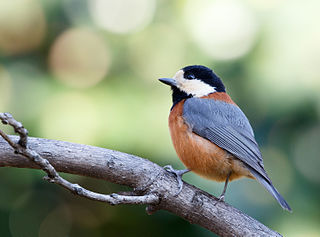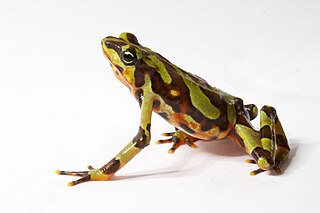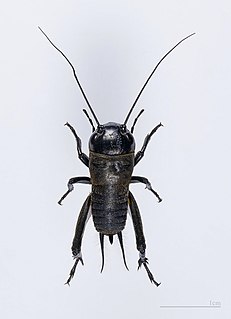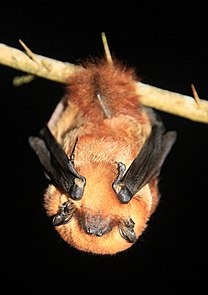
The Australian pied cormorant, also known as the pied cormorant, pied shag, or great pied cormorant, is a medium-sized member of the cormorant family. It is found around the coasts of Australasia. In New Zealand, it is usually known either as the pied shag or by its Māori name of kāruhiruhi. Older sources may refer to it as the "yellow-faced cormorant".

Chuckwallas are large lizards found primarily in arid regions of the southwestern United States and northern Mexico. Some are found on coastal islands. The six species of chuckwallas are all placed within the genus Sauromalus; they are part of the iguanid family, Iguanidae.

The painted buttonquail is a species of buttonquail, the family Turnicidae, which resemble, but are unrelated to, the quails of Phasianidae. This species is resident in Australia where numbers are believed to be in decline. A subspecies, the Abrolhos painted buttonquail, is endemic to the Houtman Abrolhos islands.

The green junglefowl, also known as Javan junglefowl, forktail or green Javanese junglefowl, is the most distantly related and the first to diverge at least 4 million years ago among the four species of the Junglefowl. Hybridization with domestic chicken has also been reported. Green junglefowl is a medium-sized bird in the pheasant family Phasianidae.

The varied tit is a perching bird from the tit family, Paridae. It occurs in the eastern Palearctic in Japan, Korea, and locally in northeastern China and extreme southeastern Russia.

Atelopus varius, the Costa Rican variable harlequin toad or clown frog, is a small Neotropical true toad from the family Bufonidae. Once ranging from Costa Rica to Panama, A. varius is now listed as critically endangered and has been reduced to a single remnant population near Quepos, Costa Rica and has only relict populations in western Panama (IUCN). Recent variation in air temperature, precipitation, stream flow patterns, and the subsequent spread of a pathogenic chytrid fungus (Batrachochytrium dendrobatidis) linked to global climate change have been the leading cause of decline for A. varius. A. zeteki has been considered a subspecies of A. varius, but is now generally considered a separate species.
The variable grass mouse is a species of rodent in the family Cricetidae. It is known only from Bolivia, where it is found at elevations from 400 to 3000 m.

The variegated flycatcher is a species of bird in the family Tyrannidae. With the crowned slaty flycatcher being moved to its own genus, this is now the only species remaining in Empidonomus.

The forest shrew is a species of shrew in the mouse shrew family, Soricidae. It is found in Lesotho, South Africa, and Eswatini. Its natural habitats include temperate forests, dry savanna, Mediterranean-type shrubby vegetation, and temperate grassland. The term "forest shrews" in the plural is sometimes confusingly used to collectively refer to a different genus, Sylvisorex.
Caconemobius howarthi is a species of cricket known by the common name Howarth's cave cricket. It is native to Hawaii.
Caconemobius is a genus of crickets in the subfamily Nemobiinae. There are about 15 species distributed from the Pacific coasts of Asia to Hawaii, where they occur in marine environments on the shores of the Pacific Ocean.
Caconemobius schauinslandi is a species of cricket known by the common name Schauinsland's bush cricket. It is native to Hawaii.

The San Esteban chuckwalla, also known as the piebald chuckwalla or pinto chuckwalla, is a species of chuckwalla belonging to the family Iguanidae endemic to San Esteban Island in the Gulf of California. It is the largest of the five species of chuckwallas, and the most threatened.

Crickets are Orthopteran insects which are related to bush crickets, and, more distantly, to grasshoppers. In older literature, such as Imms, "crickets" were placed at the family level, but contemporary authorities including Otte now place them in the superfamily Grylloidea. The word has been used in combination to describe long-recognised unrelated taxa in the suborder Ensifera, such as king crickets and mole crickets.
Ophiclinops varius, the Variegated snake-blenny, is a species of clinids found in the coastal waters of southern Australia where it resides in beds of Amphibolis seagrasses. It can reach a maximum length of 5 centimetres (2.0 in) TL.

The cinnamon red bat is a species of bat in the family Vespertilionidae. It was first described from a specimen that had been collected in Chile. For more than one hundred years after its initial description, it was largely considered a synonym of the eastern red bat. From the 1980s onward, it was frequently recognized as distinct from the eastern red bat due to its fur coloration and differences in range. It has deep red fur, lacking white "frosting" on the tips of individual hairs seen in other members of Lasiurus. It has a forearm length of 39–42 mm (1.5–1.7 in) and a weight of 9.5–11.0 g (0.34–0.39 oz).
Paragordius varius, also known as the nematomorphs or horsehair worm, are known to control their definitive host to jump into a pool of water, thus allowing the adult worm to escape and reproduce. They are similar to nematodes but are much longer and very thin. P. varius is usually found in water or wet areas. These worms definitive hosts consist of grasshoppers, crickets, cockroaches, and some beetles.
The Iriomote tit is a small passerine bird in the tit family Paridae. It is endemic to the Yaeyama Islands which lie to the south west of Japan and to the east of Taiwan. Iriomote is the name of the largest island in the group.











